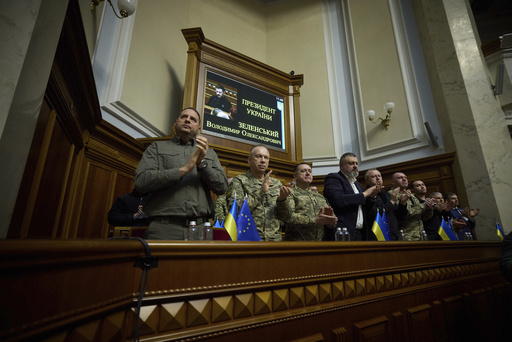
KYIV, Ukraine – President Volodymyr Zelenskyy of Ukraine has recently shared a portion of his five-point strategy aimed at nudging Russia towards resolving the ongoing conflict through negotiations. A significant aspect of this plan includes a formal proposition for Ukraine’s membership in NATO, which Western allies have hesitated to entertain until the war concludes.
Zelenskyy presented this plan to the Ukrainian Parliament on Wednesday, while withholding certain sensitive information that has been shared privately with key allies like the United States.
**NATO Membership**
The initial component of the proposal calls for an official invitation for Ukraine to join NATO in the near term. Although this would not mean imminent membership while hostilities persist, it would signify a strong commitment and illustrate how Western nations perceive Ukraine within the broader security framework. Zelenskyy remarked that for many years, Russia has taken advantage of the geopolitical ambiguity in Europe, particularly noting Ukraine’s absence from NATO as a factor that has emboldened Russian aggression.
He emphasized that this invitation to NATO is “essential for peace” in the nation. However, NATO allies are cautious, as extending such an invitation amidst ongoing conflict could complicate matters. Since the escalation of the war in 2022, NATO has encountered obstacles in moving Ukraine closer without officially inviting it to join. During their summit in July in Washington, NATO member countries declared that Ukraine is on an “irreversible” path to future membership, but decisions regarding formal talks are anticipated not to occur until the summit in the Netherlands in June.
**Military Capability**
The second aspect of the plan focuses on enhancing Ukraine’s defense mechanisms to not only fend off Russian advances but to also involve counter-offensive actions on Russian soil. This element encompasses ongoing military engagements aimed at fortifying Ukraine’s defenses in its occupied regions, as well as advancing air defense systems and collective missile interception efforts with neighboring nations.
Zelenskyy expressed a desire for a more extensive deployment of Ukrainian drones and missiles and urged allies to reconsider restrictions on using Western-supplied artillery for long-range strikes within Russian territory. Additionally, Ukraine seeks enhanced access to a wider range of intelligence and real-time satellite surveillance data, with specific aspects of this part of the plan classified for allies capable of providing effective support.
**Deterrence Measures**
In the deterrence segment of the strategy, Ukraine advocates for the establishment of a robust non-nuclear deterrence system within its borders, believed to be adequate for countering military threats from Russia. Zelenskyy did not delve into the specifics of such a deterrence system but mentioned that it would target Russian military assets, theoretically crippling Russia’s war capabilities and encouraging Moscow to enter into meaningful diplomatic discussions.
Classified elements related to deterrence have been shared with the United States, the United Kingdom, France, Italy, and Germany, while other nations that can contribute are expected to be briefed too.
**Economic Development**
The fourth part of the proposal centers on unlocking Ukraine’s economic potential and bolstering sanctions against Russia. Zelenskyy pointed out that Ukraine is endowed with rich natural resources, including essential metals worth trillions like uranium, titanium, lithium, and graphite.
He asserted that the control of these vital resources, coupled with Ukraine’s significant energy and agricultural capabilities, aligns with Russia’s central objectives in the current war, but conversely also presents an opportunity for Ukraine’s growth. The economic section further includes confidential details shared only with select partners, and Zelenskyy proposed a special agreement for the collaborative protection of Ukraine’s resources, shared investments, and the optimum utilization of its economic potential—framing this as “peace through strength.”
**Future Considerations**
Finally, the fifth element addresses the post-war scenario. Zelenskyy noted that after the conflict, Ukraine would possess a formidable military force composed of experienced soldiers.
“These personnel will have real combat experience with modern warfare, proven use of Western weaponry, and interactions with NATO forces,” he stated. He suggested that this acquired Ukrainian expertise could serve to enhance the alliance’s defensive measures and ensure security across Europe, viewing it as a valuable mission for Ukrainian soldiers. Moreover, he mentioned that, with the support of allies, Ukrainian units could potentially replace certain U.S. military forces stationed in Europe.
